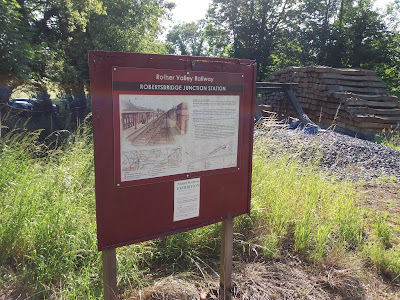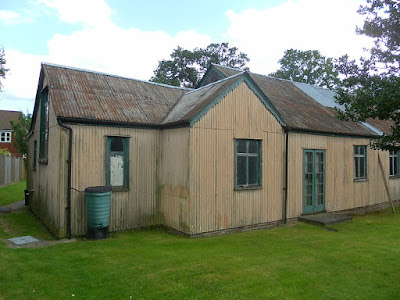I promised in the last post to provide an update on the Kent & East Sussex Railway’s plans for their heritage railway, and also on the
situation regarding the Seven Stars; the Harvey’s
pub in Robertsbridge High Street,
which has now been closed for over a year.
First the railway. Rother District District Council have
approved Kent & East Sussex Railway’s plans for a new station building,
platform, water tower, carriage shed and locomotive shed, adjacent to the
mainline station and virtually opposite the Ostrich Hotel.
They have also given the go-ahead for the restoration of the
Northbridge Street to Junction
Road section of the Robertsbridge to Bodiam
Reconnection Project. If and when this stretch of line is re-laid, and the
restoration project completed, it will be possible to travel by a heritage
train from Robertsbridge via Bodiam to the eastern end of the line at
Tenterden.
 |
| The current end of the line |
So far, so good, but there are still a number of obstacles
in the way, not least of which are the reports in the local press, back in
April, which show that two local landowners (both farmers), are holding out
against selling their section of lands to the railway. The K&ESR may be
able to compulsory purchase the necessary sections of land, but they are on
record as saying they would much rather reach an amicable agreement with the farmers
concerned.
In addition, parliamentary approval has to be obtained
before track laying can commence, and in the current uncertain political
climate, there is no indication as to when, or indeed if, there will be time to
pass the necessary legislation.
 |
| Tenterden station |
Local MP Greg Clarke, has expressed concerns over this
particular crossing, but he is only looking at the situation from the road traffic
point of view, and is ignoring the obvious economic benefit which a restored,
heritage railway would bring to the area. So whilst the longer term outlook for
restoring this section of line is looking good, there are still a number of
significant hurdles to overcome before trains can run all the way up to
Tenterden again.
Now for the Seven Stars. As mentioned earlier, this fine old
14th Century inn remains firmly closed. The pub is owned by Harvey’s, who
are reported as having difficulty in finding suitable tenants for the pub. Some
have argued that this may be due to the high rent which the brewery are asking;
reported to be £50,000 pa, and with business rates of £15,000 on top, it is
perhaps not surprising that no tenants have come forward.
This is not the first pub Harvey’s have had difficulties
with in recent years; as the Two Brewers
at Hadlow, in our own branch area, has seen a succession of tenants come
and go. It may just be hearsay, but it appears Harvey’s
may have joined the Pub Co’s in charging “market-led” rents; rather than something
more realistic, which would work for both the brewery and any prospective tenants.
It may be that there is insufficient trade in a village the
size of Robertsbridge, to support three
pubs; but on the other hand are the brewery just being greedy? I am surprised
that Harvey’s have not installed an
interim manager at the Seven Stars, as that way they could continue to draw
revenue from the place, whilst re-building the trade. This would obviously be
to the advantage of any incoming tenants, and ultimately to the brewery as
well, so this type of arrangement would surely benefit both parties.
Perhaps this is a little too obvious, or perhaps the brewery
wish to demonstrate that the pub is no longer viable. If so, this is a sorry
state of affairs, and one which is not befitting of a fine old independent
family brewery like Harvey’s.
So these are the updates of what is happening in
Robertsbridge at present. Will the heritage rail link be restored, and will it
be possible to travel up top Tenterden in a vintage carriage, hauled by a steam
locomotive? Equally, will I get the chance to enjoy a few pints at the
Seven Stars? I’ve never set foot inside, and it would be nice to do so, but are
economics no longer in the pub’s favour?
Despite all these “ifs and buts”, Robertsbridge is still a
place well worth visiting and, if time allows, so is the surrounding
countryside.











































